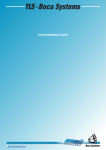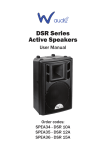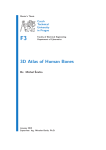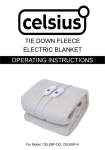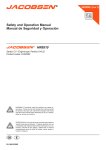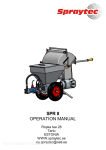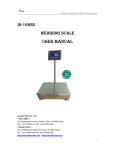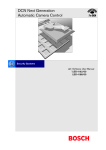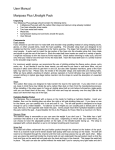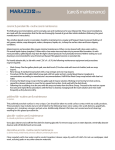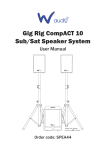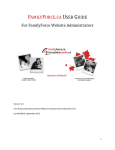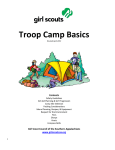Download (SEEDS) Student Report SEEDS Gear Dryer Steven Baird Mike
Transcript
UBC Social Ecological Economic Development Studies (SEEDS) Student Report SEEDS Gear Dryer Steven Baird Mike Dickson Jonathan Lau Josh Pires University of British Columbia MECH 457 April 11, 2011 Disclaimer: “UBC SEEDS provides students with the opportunity to share the findings of their studies, as well as their opinions, conclusions and recommendations with the UBC community. The reader should bear in mind that this is a student project/report and is not an official document of UBC. Furthermore readers should bear in mind that these reports may not reflect the current status of activities at UBC. We urge you to contact the research persons mentioned in a report or the SEEDS Coordinator about the current status of the subject matter of a project/report”. SEEDS Gear Dryer MECH 457 April 11 th , 2011 Steven Baird Mike Dickson Jonathan Lau Josh Pires i Table of Contents Objectives ................................................................................................................................................. 1 Design and Testing .................................................................................................................................... 1 Bicycle and Support Structure .............................................................................................................. 3 Rear Hub ............................................................................................................................................... 4 Gearbox and Mounting ......................................................................................................................... 5 Spinner and Mounting .......................................................................................................................... 5 Safety .................................................................................................................................................... 7 Verification Testing ............................................................................................................................... 8 Conclusions ............................................................................................................................................... 9 Recommendations .................................................................................................................................... 9 What We Suggest the Client Should Do Next ..................................................................................... 10 Appendices..................................................................................................................................................... i Appendix A - Project Abstract ............................................................................................................ A-1 Appendix B - Dossier 1.........................................................................................................................B-1 Project Title: TREK Gear Dryer ...............................................................................................................B-1 Sponsor Contact Information: ...............................................................................................................B-1 Problem Statement: ...............................................................................................................................B-1 Team Member Contact Information: .....................................................................................................B-1 Appendix C - Dossier 2......................................................................................................................... C-1 Appendix D - Web Survey ................................................................................................................... D-1 Web Survey Questions .......................................................................................................................... D-1 Introduction ...................................................................................................................................... D-1 Commute Patterns ............................................................................................................................ D-1 Commute Time.................................................................................................................................. D-1 Cycling and Weather ......................................................................................................................... D-1 Wet Gear ........................................................................................................................................... D-1 A New Apparel Dryer ........................................................................................................................ D-2 Bike Gear Priorities ........................................................................................................................... D-2 Other Items ....................................................................................................................................... D-4 i Payment ............................................................................................................................................ D-4 Energy Use ........................................................................................................................................ D-4 Energy Supply.................................................................................................................................... D-4 Drying Preference ............................................................................................................................. D-4 Drying Time ....................................................................................................................................... D-4 Waiting Time ..................................................................................................................................... D-5 Demographics ................................................................................................................................... D-5 Primary Reason for being at UBC ...................................................................................................... D-5 Follow Up .......................................................................................................................................... D-5 Contact Information.......................................................................................................................... D-5 Initial Web-Survey Findings .................................................................................................................. D-6 Commuting Patterns ......................................................................................................................... D-6 Usefulness ......................................................................................................................................... D-8 Waiting Time ..................................................................................................................................... D-8 Drying Time ..................................................................................................................................... D-10 Apparel Priorities ............................................................................................................................ D-11 Human-Powered ............................................................................................................................. D-12 Usage Statistic ................................................................................................................................. D-12 Appendix E - Dossier 4: Proposal......................................................................................................... E-1 Appendix F - Dossier 5: Research ........................................................................................................ F-1 Purpose .................................................................................................................................................. F-1 Findings .................................................................................................................................................. F-1 5,555,640 – Multipurpose Household Drying Center ............................................................................ F-1 6,370,798 – Clothes Dryer with Vacuum Assistance ............................................................................. F-2 7,770,305 – Clothes Drying Apparatus .................................................................................................. F-2 5,163,895 – Centrifuge-Dryer with Horizontally Supported Rotating Drive Shaft ................................ F-3 Conclusion .............................................................................................................................................. F-3 Power Output......................................................................................................................................... F-4 Sources: .................................................................................................................................................. F-4 Existing Technologies ............................................................................................................................. F-5 Home-made Bicycle-Powered Clothes Dryer......................................................................................... F-5 Clothing Materials .................................................................................................................................. F-5 ii Bicycle Shorts ......................................................................................................................................... F-5 Rain Jacket ............................................................................................................................................. F-5 Appendix G - Dossier 6: Concept Generation ..................................................................................... G-1 Sketches of Initial Concepts .................................................................................................................. G-1 Compaction/Squeeze Concepts ............................................................................................................ G-1 Vertical Press..................................................................................................................................... G-1 Wringer ................................................................................................................................................. G-2 Centrifugal Concepts ............................................................................................................................. G-2 Spinner .............................................................................................................................................. G-2 Spinner with Self-Energizing Brake for Compaction ......................................................................... G-3 Thermodynamic .................................................................................................................................... G-4 Vacuum Pumping .............................................................................................................................. G-4 Evaporative Drying ............................................................................................................................ G-5 Suction .................................................................................................................................................. G-6 Appendix H - Dossier 6: Concept Selection......................................................................................... H-1 Introduction .......................................................................................................................................... H-1 Concept Winnowing.............................................................................................................................. H-1 Weighted Decision Matrix .................................................................................................................... H-1 Experimental Results & Conclusion ...................................................................................................... H-2 Appendix I - Dossier 7: CFP.................................................................................................................. I-1 Purpose: .................................................................................................................................................. I-1 Test Description: ..................................................................................................................................... I-1 Resources: ............................................................................................................................................... I-1 Timeline: ................................................................................................................................................. I-1 Results: .................................................................................................................................................... I-1 Conclusion and Recommendations: ....................................................................................................... I-2 Background: ............................................................................................................................................ I-3 Purpose: .................................................................................................................................................. I-3 Required Resources: ............................................................................................................................... I-3 Timeline: ................................................................................................................................................. I-3 Possible Sources of Error: ....................................................................................................................... I-4 Expected Results: .................................................................................................................................... I-4 iii Results and Discussion ............................................................................................................................ I-5 Recommendations .................................................................................................................................. I-5 Purpose: .................................................................................................................................................. I-7 Required Resources: ............................................................................................................................... I-7 Timeline: ................................................................................................................................................. I-7 Results: .................................................................................................................................................... I-7 Hang Dry: ................................................................................................................................................ I-7 Low Speed Air Dry: .................................................................................................................................. I-7 High Speed Air Dry: ................................................................................................................................. I-8 Interpretation of Results: ........................................................................................................................ I-9 Future Considerations:............................................................................................................................ I-9 Appendix J - Dossier 8: System Architecture ...................................................................................... J-1 Function Structure Diagram ................................................................................................................... J-1 System Architecture Block Diagram....................................................................................................... J-2 Modelling ............................................................................................................................................... J-2 Optimizing .............................................................................................................................................. J-4 Appendix K - Dossier 9: Financials and FMEA ..................................................................................... K-1 Appendix L - Dossier 10....................................................................................................................... L-1 Introduction ........................................................................................................................................... L-1 Construction Process ............................................................................................................................. L-1 Major Components: ............................................................................................................................... L-2 Base Frame......................................................................................................................................... L-2 Front Fork ........................................................................................................................................... L-3 Rear Hub ............................................................................................................................................ L-4 Gear box ............................................................................................................................................. L-6 Motor Hub.......................................................................................................................................... L-6 Spinner Support ................................................................................................................................. L-7 Construction Flow Chart ........................................................................................................................ L-9 Plan for Completion ............................................................................................................................. L-10 Remaining Tasks:.................................................................................................................................. L-10 Sprockets Installed ........................................................................................................................... L-10 Base frame welded .......................................................................................................................... L-10 iv Gear Box Height Fixed ...................................................................................................................... L-10 Shaft Extension Completed and installed ........................................................................................ L-11 Spinner Frame Holes drilled for motor hub ..................................................................................... L-11 Spinner Casing cut and secured to table.......................................................................................... L-11 Brake system .................................................................................................................................... L-12 Safety Shielding ................................................................................................................................ L-12 Validation Testing ............................................................................................................................ L-12 Appendix M - Dossier 11..................................................................................................................... M-1 Introduction ......................................................................................................................................... M-1 Description of Final Design .................................................................................................................. M-1 Detailed Engineering Calculations ....................................................................................................... M-3 Installation Manual .............................................................................................................................. M-4 Service and Operator Manual .............................................................................................................. M-5 Appendix N - Dossier 12...................................................................................................................... N-1 DOSSIER PHASE 12 - VALIDATION ......................................................................................................... N-1 Rational ............................................................................................................................................. N-1 Methods ............................................................................................................................................ N-1 Results ............................................................................................................................................... N-1 Conclusions ....................................................................................................................................... N-2 DOSSIER PHASE 12 - VERIFICATION ...................................................................................................... N-4 Rational ............................................................................................................................................. N-4 Methods ............................................................................................................................................ N-5 Procedure:......................................................................................................................................... N-5 Expected Results: .............................................................................................................................. N-5 Results ............................................................................................................................................... N-5 Conclusions ....................................................................................................................................... N-7 Appendix O - Drawings ....................................................................................................................... O-1 v Objectives UBC Transportation and Planning has asked for a device that will quickly and effectively dry the basic cycling apparel, while using minimal electricity from the grid, for commuters that cycle to the University of British Columbia in wet weather. See Appendix A: Project Abstract for the original project abstract. There are commercially available products that offer decent drying capabilities including the Suitmate Dryers or Spin X dryers. However these products are not designed to minimize their environmental impact, nor are they proven to operate in outdoor climates. See Appendix E: Proposal under Initial Survey of Existing Alternatives for details on these products. To better understand the user expectations of such a device, a web survey was distributed to the users of the UBC bike cages. Survey questions focused on details about the commuter's trip. The web survey questions and choices are detailed in Appendix D: Web Survey. Through this survey cyclists expressed their annoyance with putting on wet/damp gear at the end of their day, verifying the requirement for such a device. For the detailed survey analysis, see Appendix D: Web Survey under Web Survey Findings. Based on the survey results, the team was able to develop a list of specifications and evaluation criteria that the device would have to meet to be deemed a success. The evaluation criteria that was most critical to the project's success was to have an operation time of less than three minutes, consume <200 Watts of power, and have a comparable final dryness to that of the commercially available products. The full list of evaluation criteria can be found in Appendix E: Dossier 4 - Proposal pages 14-15 and a complete list of product specifications is attached in Appendix C: Dossier 2 - Product Specifications. With the evaluation criteria outlined, the team developed various concepts that would complete the functions required. See Appendix G: Dossier 6: Concept Generation for details on the various concepts generated. Through a Weighted Decision Matrix (WDM), attached in Appendix H: Dossier 6 - Concept Selection the team narrowed the design to three major concepts: convective drying, centrifugal spinning, and compressive wringing. These three concepts were tested as part of the Critical Function Prototyping required and the experiments and results are located in Appendix I: Dossier 7 - CFP. From these experiments the team chose to go forward and develop a centrifugal spinner design to complete the task of drying user's clothing. Design and Testing With the decision to use a centrifugal spinner, the team needed to decide how to transfer the energy from a user powered device, to the vertical spinning basket that would house the wet clothing. 1 A B D C Figure 1: Full Device Layout The device functions by having the user pedal a stationary bike. The rotation of the pedals is connected via the bike chain to the rear axle. On this axle (A in image 1 above) is another sprocket which is connected to a 90° gearbox (B in image 1 above) with a chain. A third chain (C in image 1 above) connects the vertical output of the gearbox to a sprocket on the spinner (D in the image 1 above). The final gearing of the system is 39.2:1. Since research has shown that the average bike user can output approximately 80 rpm at a steady rate, (see Appendix F: Dossier 5 - Research) this equates to a spinner rpm over 3100 rpm, encompassing the target of 2400 rpm. This system architecture is outlined in Appendix J: Dossier 8. The final design consists of 4 major sections (See image 2 below): the bicycle, the rear hub transmission, the 90 degree gearbox, and the vertical shaft and spinning basket. Each of these components also incorporates the required supporting structures and alignment features that allow the device to properly operate, as well as the necessary safety features. 2 Figure 2: Device Components Bicycle and Support Structure The bicycle used in this project was donated to the team by the UBC Bike Kitchen. The bike required a stiff mounting structure to minimize wobble during operation and to support the weight of the rider. An initial structure was created out of 1-½“ angle iron in time for the preliminary prototype presentation. Figure 3: Initial Bike Support Frame However, during the Validation stage (see Appendix N: Dossier 12 - Validation) this structure was deemed to be too unstable so the stiffer structure seen below was designed and manufactured. 3 Figure 4: New Bike Support Structure This new, more rigid, structure includes a slimmed-down profile to allow easy access for users as well as being more visually appealing. Rear Hub Because the original hub was removed with the rear tire, and since the team needed to install a second sprocket on the hub to provide transmission to the system, a custom machined hub was constructed to hold original the cassette and the new large sprocket. Figure 5: Rear Hub (Drawings in Appendix O: Drawings) A key design decision at this point was to incorporate high quality components into the system. This decision prolongs the lifetime of the device, reduces maintenance 4 intervals and costs, and since the device operates in a wet weather environment, prevents rusting by choosing Stainless Steel sprockets and shafts. Gearbox and Mounting The linking component of the transmission system is the gearbox. Figure 6: Gearbox Mount This provides the 90 degree transition required. A critical decision here was to go with a McMaster Carr gearbox instead of fabricating our own, or using a twisted flat belt with sheaves. Purchasing this component guarantees efficient operation and mounting ease. A noteworthy design at this point in the system is our innovative mounting and chain tensioning system. The gearbox is mounted to a study square tube frame. This frame locates the sprocket on the horizontal shaft in the same plane as the sprocket on the rear hub, as well as locating the vertical shaft sprocket at the same height as the sprocket on the spinner shaft extension. This guarantees the sprockets are correctly located. The chains are tensioned individually by sliding either the Gearbox Mounting frame or the Spinner Table. The angle iron pieces that support these two items are slotted on the vertical face. Slotted to allow sliding Figure 7: Gearbox Mounting Slots This allows the gearbox mount to slide up to 1” to tighten the bike-gearbox chain as required and similarly allows the spinner table to slide up to 2” to tighten the gearbox-spinner chain as required. Designing the system this way allows for all of the pieces to be permanently in place before tensioning the chains as well as it allows for the chains to be replaced if necessary. Spinner and Mounting The spinner basket itself was salvaged from the Spin Dryer tested in the original CFP phase. 5 Table Black Flange Brass hub Figure 8: Salvaged Spinner Basket and Shaft This spinner unit consisted of a stainless steel basket on a shaft. Mounted to this shaft were two ball bearings. The bearings were axially located using black plastic flanges and the original brass motor hub. Using these salvaged pieces saved machining costs and time and provided a guarantee fit around the bearings. The black flange also provided an ideal point to secure the spinner to the support table as well as a great mounting position for the brake. The original spinner shaft needed to be modified to allow for the sprocket to be placed on the end. Figure 9: Shaft Extension See Drawings in Appendix O: Drawings. The shaft extension was designed such that when the device is in operation the forces on the shaft will assist in tightening the shaft onto the thread, preventing the shaft extension from unscrewing. The inventive spinner support table allows the spinner to be installed/ removed from the table easily. 6 Slot in table Figure 10: Spinner Table The table can slide apart so the spinner and components can be maintained or replaced easily. A key design theme throughout this project was to make maintenance as easy as possible for the client.. Safety The final component of the design is the safety mechanisms. The protective casing and lid from the original spinner were kept to protect users from the sharp outer edges of the spinner basket as well as to retain the water inside the casing. Figure 11: Basket in Casing Expanded metal sheets were installed around the spinner table to provide shielding which protects users from the chains and high-speed gears – as well as providing extra rigidity to the spinner table. 7 Figure 12: Safety Shield These protective sheets were secured with standard nuts and bolts to retain client accessibility to the gearbox and sprockets if necessary. Finally, a salvaged bicycle brake was installed so the user can safely and quickly stop the spinner basket before opening the access lid. This brake is creatively mounted underneath the spinning basket and clamps around the original motor core. Brake Pad Around Core Figure 13: Brake System Verification Testing Verification Tests were conducted to determine how the device designed by the team compares to the commercially available Spin Dryer. The team planned to test a range of RPM's to verify the device. However, above 650 RPM, the device encountered a violent resonance point. To prevent serious damage to the sprockets, chains, and components, the tests were stopped while a solution could be found. See Appendix N: Dossier 12 - Verification for the full test plan and results. 8 A correlation between spinner RPM and water removed could still be determined with the data collected however. Fitting an exponential curve allowed us to extrapolate the data out to 2400 RPM. At this point, the device is nearly identical to the original Spin Dryer. % Water Left wrt Dry Weight Extrapolation of % Water Left to 2400 RPM 100 y = 100.56e-9E-04x 80 60 Experimental Results 40 Extrapolation Results 20 Target Value 0 0 400 800 1200 1600 2000 2400 RPM Since we were only able to test the lower RPM range due to instabilities in the system, it is difficult to directly compare the device to the original Spin Dryer. However, it can be seen that if the device is improved such that higher RPMs are achievable, the device should easily perform as well as the original Spin Dryer. Improvements to the design required to reach the required RPM are outlined in the Recommendations section below. Conclusions To conclude, the device in its current state is a benefit to the client and UBC cyclist commuters. The device is better than the current options: hand wringing or hanging in lockers/office, and cyclists that commute to campus in heavy rain will notice and appreciate the device as it is. The device also manages to function using zero electricity, thereby promoting sustainability at UBC - a key requirement for the client. Recommendations While the device is an improvement over the current option for cyclists, there are some adjustments that the team recommends should be completed in order for the device to run at its optimal speed. Some of these recommendations will be in place for the final project handoff on April 21st 2011, while others are suggested improvements that could be undertaken by a subsequent MECH 45X design team or group of the Client's choosing. 9 First and foremost, the device needs improvements to be balanced and supported such that the vibrations caused at higher frequencies are eliminated. There are a few solutions to this problem and as mentioned, some will be implemented by the team before the final project handoff. • A quick option to eliminate the chain whipping that was encountered at 700 RPM is to shorten the chain length between the gearbox and the spinner shaft by moving the gearbox mount towards the spinner shaft, thereby decreasing the centre to centre distance. • The best option to reduce the vibrations in the device is to design and fabricate a new mounting structure for the spinner shaft. The plastic flange and brass hub that were salvaged from the original motor proved to be too flimsy to withstand the torsion applied to the system. A dedicated housing made from stiffer metal is ideal. This would be mounted either to the underside of the spinner table, or bolted to the concrete floor. • Another option to reduce the magnitude of vibrations encountered would be to limit the height of the spinner table by raising the effective ground level by placing large blocks under the table legs to act as supports and dampers. Some other modifications that could improve the device that the team would recommend if time allowed would be to add a user interface option so cyclists have some feedback while operating, mounting the brake on the lid so the device can’t be opened while spinning, and routing the accumulated water to a nearby planter box to promote sustainability. What We Suggest the Client Should Do Next The team suggests that the above recommendations be completed before installing the device permanently. The suggested Installation Instructions, Service and Maintenance Manual, and Operation Guide is located in Appendix: M - Dossier 11. 10 Appendices i Appendix A - Project Abstract A-1 A-2 Appendix B - Dossier 1 Project Overview Form Project Title: TREK Gear Dryer Sponsor Contact Information: Adam Cooper Coordinator, TREK Program Centre #110-2075 Wesbrook Mall, GSAB Vancouver, B.C. Canada V6T 1Z1 Tel: 604.822.8735 Fax: 604.827.5825 E-mail: [email protected] Web: www.trek.ubc.ca Problem Statement: To design a device that dries cyclists’ wet cycling gear in an amount of time specified by end-user interviews. The device must also process the waste water extracted from the cycling gear in an environmentally responsible manner. If electrically powered, the device will ideally take advantage of alternative energies. Finally, the overall footprint and maintenance requirements must be minimized. Team Member Contact Information: Name Jonathan Lau Joshua Pires Michael Dickson Steven Baird Phone 778.232.5086 604.816.8654 778.232.1370 604.454.8787 Email [email protected] [email protected] [email protected] [email protected] City/Town Richmond Point Grey Campus Point Grey Campus Burnaby (Term 1) B-1 Memorandum Date: September 27, 2010 To: Dr. Paul Winkelman, Adam Cooper From: Michael Dickson Subject: Meeting Notes from Sep 22, 2010 Introductory Summary This memo summarizes the results from our initial meeting on September 22, 2010, and outlines our next steps in the design process. Meeting Summary There is a ten year plan to expand the number of secure bike cages on campus from five to sixteen. The plan includes the installation of gear dryers at each of these locations. The first gear dryer will be installed at the presently-under-construction Buchanan tower bicycle cage. In order to estimate the required machine capacity and throughput, Adam has statistics he can provide to the team regarding the inflow and outflow of cyclists as measured across six screenlines into the campus, as well as ridership information and demographics. During our discussions, our team noted that Adam identified the following design issues: • Device needs to be able to dry rain jacket, over-shorts and booties • Waste water needs to be uniquely/creatively utilized • Electricity use should be minimal (or none at all) • Maintenance (i.e. cleaning and sanitizing) should be easy and minimized • Rate of drying needs to suit end-user needs B-2 • Form factor needs to be suitable for bike cage Adam has contacts at Vancouver City Hall who can arrange for a site visit to observe their integrated drying system. Next Steps Pending the availability of Vancouver City Hall, the team will be conducting the site visit on September 28, 2010, from 12:30 to 1:30. In order to gauge the needs of the end users, group interviews or web-based surveys need to be conducted on a random sample of the bike cage users. Following the interviews, storyboarding and flowcharting of the use cases will be created, and the user needs will be transformed into a set of functional requirements which fulfill the use cases. B-3 MECH 457 Dossier 1 Component Market Assessment Note: This market assessment was carried out ahead of user interviews. Further revisions may be made. Methods: In order to assess the market for the Gear Dryer, three key pieces of information were required. These are: 1. Identification and classification of consumers, who, because of the specific function, value and benefit of the gear dryer, are likely to purchase the product 2. Estimation of the size of each market segment identified above 3. Estimation of the price-point for each market segment Results: To find maximise the scope of potential consumers, the functional description of the gear dryer was simplified from “drying cycle clothes quickly”, to “drying wet fabrics quickly”. Online research and team brainstorming resulted in the list below: • • • • • • Universities (First consumer) Small / Large Businesses Regional Planning Centres Bike Advocacy Groups Community Recreation Centres Cross-market Consumers (Ski resorts, swimming pools, water parks etc.) To place a dollar value on each market, two elements were researched: size of the market segment and the number of units per customer. Some of the results are shown below: Market Segment Number of units per customer GVRD (municipality) & 1each at roughly 50 Universities different location throughout lower mainland Community and 1 each, at approximately Recreational Centres 300 rec. centres. (community centres) Customer Value per unit $500 - $1000 Market Segment Size $500 - $1000 $225,000 $37,500 B-4 Small / Large Business (>100 people) Ski Resorts 1 each, at approximately 1000 businesses 10 each, at 5 ski resorts in the lower mainland $500 - $750 $625,000 $1000 $50,000 Total Market Size: $937,500 The customer value was justified by comparing the price of alternative solutions. Conventional dryers, although not suited to drying cyclist clothing, vary in price from $500 - $1000. Ski resorts may look for higher-volume or more feature-rich conventional clothes dryers than, say, small businesses or community rec. centres. Other variances in price-point between market segments include operational costs, which are highly volume dependent, and the potential to combine loads in a conventional clothes dryer. The final estimate on the market size is $937,500. Conclusion: Based on an initial assessment of the target market, it was concluded that small/large businesses, community recreational centres, municipalities and universities have very similar functional needs and but vary in terms of required processing quantities. Due to its vast size, the small/large business market segment is the ideal consumer. It comprises $625,000 of the estimated $937,500 total market. Also, of note, the first consumer is part of the university/municipality category. B-5 Appendix C - Dossier 2 Gear Dryer Product Specifications (Early Draft) Design Region Function Metric Drying time Value < 1 minute Undesirable Power usage < 200 Watts if human powered Function Final Dryness To be determined through market research Ergonomics Loading Time <20 seconds Function Capacity > 10L Other Cleaning time < 15 minutes Other Cleaning interval 7-14 days during heavy use Constraint Overall Dimensions Product Lifetime Max 3' wide, 4' deep, 6' high >20,000 cycles Function Water Storage (if applicable) >15L Point estimate: 0.5 L/use * 30 uses/day * 1 tank draining/day Durability Rugged, Durable Can withstand >15kg weight Function Physical Stress Applied to Raingear < 2 Newtons Estimate about 2L per article - jacket, rain pants, gloves, booties + extra allowance (2L=2kg using water density) Reduce damage to clothing Storage Justification Value to be obtained via the surveys and interviews Great athletes output about 400W continuously. Allowances have to be made for the lowest common denominator level of fitness Value to be obtained via experimentation Majority of time should be spent drying the clothes rather than preparing them for drying Estimate about 2L per article - jacket, rain pants, gloves, booties + extra allowance Similar to time needed to thoroughly clean a toilet More than weekly cleaning would be an excessive strain on maintenance resources Allotted space in Buchannan bike cage Point estimate: 30 uses/day * (365 days/year * 0.25 wet days) * 7 years = 19,162 C-1 Appendix D - Web Survey Web Survey Questions Help us understand your end of trip cycling needs. Introduction UBC SEEDS (Social, Ecological, Economic, Development Studies) is Western Canada’s first academic program that combines the energy and enthusiasm of students, the intellectual capacity of faculty and the commitment and expertise of staff to integrate sustainability on campus. The TREK Program Centre, UBC's Transportation Planning Office, has teamed up with a group of engineering students through the SEED's program to create an apparel drying system aimed at improving the end-of-trip conditions for commuter cyclists. The responses you provide to this survey will be used to focus and direct the design effort. Commute Patterns On average, how often do you commute by bicycle into campus between September and April 4 or more times a week 2 or more times a week At least once every two weeks At least once a month Commute Time On average, how many minutes does your one-way cycling commute to campus take? (Please enter a numerical value) Cycling and Weather What is your attitude towards cycling to campus in the rain? The rain is not a factor for me I try my best to avoid cycling in the rain I don't like cycling in the rain, but I do it I have never cycled in the rain Wet Gear Please describe how you store your wet clothing, and how you dry them out. Also include any additional strategies you use to deal with your wet clothing. D-1 A New Apparel Dryer How useful would apparel drying facilities installed at TREK's secure bicycle storage facilities across the campus be to you? Very Useful Somewhat Useful Not Useful At All Bike Gear Priorities Please rank, in order of importance, the top 5 items you would want to dry if the opportunity existed. (1 = highest priority, 5 = lowest priority) Rain Jacket 1 2 3 4 5 Rain Pants 1 2 3 4 5 Gloves 1 2 3 4 5 Baselayer 1 2 3 4 5 Cycling Jersey 1 D-2 2 3 4 5 Cycling Shorts 1 2 3 4 5 Casual Shirt 1 2 3 4 5 Casual Pants 1 2 3 4 5 Shoe Booties 1 2 3 4 5 Socks 1 2 3 4 5 D-3 Other Items What other items might you want to dry if the opportunity existed? Payment Would you be willing to pay a fee to dry your apparel? Yes, a one-time access fee Yes, a per-use fee No Energy Use How important is it for a gear drying machine to minimize its energy consumption and environmental impact? Very Important Somewhat Important Not Important At All Energy Supply Would you use this machine if it was human-powered? Yes Yes, but less frequently No Drying Preference Do you prefer to: Wait on the spot while your apparel dries Leave your apparel to dry while you are at UBC No preference Drying Time If you could leave your apparel to dry while you were at UBC, approximately how many hours would your apparel have to dry on average? (Please enter a numerical value) D-4 Waiting Time If you could wait on the spot for your apparel to dry, how long would you be willing to wait? Less than 2 min. Less than 5 min. Less than 10 min. Less than 15 min. Not willing to wait. Demographics Primary Reason for being at UBC Please identify yourself from the list below Undergraduate student Graduate student Faculty Staff Other - please specify ______________________ Follow Up Would you be available for an interview at a later date? Yes No Contact Information If you would like to be entered into a prize draw, or responded "yes" to the question above, please provide your email below. (All information will be kept confidential and used only for the purposes of this project) D-5 Initial Web-Survey Findings October 25, 2010 Commuting Patterns When asked how often one commutes into UBC by bicycle between September and April, the responses were as follows: Category At least once a month At least once every two weeks 2 or more times per week 4 or more times per week Total Count 4 4 20 39 67 The options were chosen specifically to achieve a good sampling distribution. Each option corresponds to the following number of trips into UBC per month: Category At least once a month At least once every two weeks 2 or more times per week 4 or more times per week Rides per Month MIN MAX 0 1 2 7 8 16 17 30 Respondents were assumed to achieve the maximum number of rides per month for their category1, thus the number of trips per group were calculated: Category At least once a month At least once every two weeks 2 or more times per week 4 or more times per week Total Trips 4 28 320 1170 1522 1 Other calculations were tried, such as the minimum number of rides per month, and the average number of rides per month, but it turned out that the most conservative end result was calculated with the maximum number of rides per month. D-6 Finally, a statistic termed the Modeshare Percentage was calculated as the fraction of total trips each category represented: Category At least once a month At least once every two weeks 2 or more times per week 4 or more times per week Total Trips 4 28 320 1170 1522 Modeshare Percentage 0.3% 1.8% 21.0% 76.9% 100.0% Modeshare Percentage 90.0% 80.0% 70.0% 60.0% 50.0% 40.0% 30.0% 20.0% 10.0% 0.0% At least once a month At least once every two weeks 2 or more times per week 4 or more times per week The survey reveals that 97.9% of the trips into UBC by bicycle are done by those who cycle 2 or more times per week. In other words, there is a very small contingency of infrequent riders. This contingency, which represents about 12% of the cycling population, generates only 2% of the inbound cycling traffic. As such, these users were subsequently dropped from the dataset. The number of trips per cyclist per month can then be approximated as: 320 + 1170trips/month = 25.3trips/person ⋅ month 20 + 39person The only further question that TREK might be interested in investigating is why the 12% of cyclists who ride less than twice per week are not commuting more often. D-7 Usefulness Out of the remaining 57 respondents (those who cycle into UBC two or more times per week), the following feedback was received when asked about the usefulness of an apparel dryer: Response Not Useful at All Somewhat Useful Very Useful Total Count Percentage 8 14% 29 51% 20 35% 57 100% Based on the responses, approximately 86% consider the apparel dryer as a useful device. This is a useful starting point for estimating how much use the apparel dryer will see in a typical month. The respondents who indicated the apparel dryer would not be useful at all were asked no further questions about the technology. Demographics and contact information (when supplied by the respondent) were collected for all users in case future assessments need to be made. Waiting Time The remaining respondents were asked how long they would be willing to wait for a quick-dry machine to dry their apparel. The sample size was 49 (those who cycle into UBC two or more times per week AND view the apparel dryer as useful). The respondents answered as shown: Category Not willing to wait Less than 2 min. Less than 5 min. Less than 10 min. Less than 15 min. Total Count 4 10 19 14 2 49 Under the general assumption that a respondent who chose, for example, “Less than 10 minutes” would also be satisfied by “Less than 5 minutes” and “Less than 2 minutes” and “Not willing to wait” (i.e. 0 minutes), but not “Less than 15 minutes”, the following data was calculated: Category Not willing to wait Less than 2 min. Less than 5 min. Less than 10 min. Less than 15 min. Total Count 4 10 19 14 2 49 Satisfied Population % 100% 92% 71% 33% 5% D-8 Plotting the satisfied population percentage against their respective maximum waiting time creates a smooth curve. The curve was fitted with a linear equation. As indicated in the tabulation, for a drying time of 3 minutes, approximately 81% of the sampled population will be satisfied with the apparel dryer’s quick-dry waiting time. Satisfied Population Percentage vs Waiting Time (n=49) 100% 90% y = -0.0642x + 1 R² = 0.9933 % Satisfied Population 80% 70% 60% 50% 40% 30% 20% 10% 0% 0 2 4 6 8 10 12 14 16 twait (min) 0 1 2 3 4 5 6 7 8 9 10 11 12 13 14 15 16 % Satisfied 100.0% 93.6% 87.2% 80.8% 74.3% 67.9% 61.5% 55.1% 48.7% 42.3% 35.8% 29.4% 23.0% 16.6% 10.2% 3.8% 0% Waiting Time (minutes) Satisfied Population % Linear (Satisfied Population %) D-9 Drying Time When asked how long a slow-dry machine would have to dry one’s clothes while they were at UBC, respondents answered as follows: Count 5 6 6 2 4 11 6 7 2 49 Satisfied Population % vs Drying Time Histogram (n=42) 30% % Satisfied Population Binned Time (hrs) 1 2 3 4 5 6 7 8 9 25% 20% 15% 10% 5% 0% 1 2 3 4 5 6 7 8 9 Drying Time (hours) In similar fashion to the waiting time statistic, the satisfied population was tabulated as shown: Satisfied Population % 100% 90% 76% 67% 62% 55% 29% 19% 5% Satisfied Population % vs Drying Time (n=42) 100% % Satisfied Population Time (hrs) 1 2 3 4 5 6 7 8 9 y = -0.1171x + 1.1435 R² = 0.9759 80% 60% 40% 20% 0% 0 2 4 6 8 10 Drying Time (hours) Satisfied Population % Linear (Satisfied Population %) D-10 To achieve the same level of satisfaction as in the 3 minute quick-dry solution, the drying time for the slow-dry system would have to be less than about 2.5 hours Apparel Priorities When presented with a list of clothing options, and asked to rank from 1 to 5 the most important items, it was found that the ambiguity in the question had not been fully eliminated. Some users ranked every single item on a scale of 1 to 5, others ranked just a few items, each on a scale of 1-5 again. Others only used the numbers 1-5 once. Even though the latter was the intended scoring system, the data still meaningful. The available categories were: • • • • • • • • • • Gloves Socks Rain Jacket Rain Pants Baselayer Shoe Booties Cycling Jersey Cycling Shorts Casual Pants Casual Shirt For each category, the scores were tallied up. When a user left a particular category unranked, it was penalized2 with a score of 10. The tallies were divided by the number of respondents (n=49) and then subtracted from a maximum score of 10. The comparison is shown below, where a larger relative score indicates a higher priority: Gloves Socks Rain Jacket Rain Pants Baselayer Shoe Booties Cycling Jersey Cycling Shorts Casual Pants Casual Shirt 6.20 5.63 4.55 4.51 4.20 3.51 2.76 2.45 2.02 2.00 2 Multiple penalty scores were tried, ranging from 5 to 50. All yielded the same end result, albeit with different relative scores. D-11 Apparel Priorities (n=49) 7.00 Relative Score 6.00 5.00 4.00 3.00 2.00 1.00 0.00 The data shows that the most important items are gloves, socks, rain outerwear and baselayers. Human-Powered When asked whether one would use the apparel-dryer if it was human-powered, the respondents answered as shown: Response Yes Yes, but less frequently No Count Percentage 31 63% 10 20% 8 16% 49 100% Of those who answered “Yes” or “Yes, but less frequently”, it was found that 75% responded that the amount of electrical energy the device uses was “very important” to them. Of those who responded “No”, it was calculated that they represent only 1.1% of the bicycle trips into UBC. Usage Statistic It is worthwhile to estimate what percentage of the cycling population find the apparel dryer useful and suitable to their needs. This will provide an estimate on how much usage the device will see on a monthly basis. Assuming a 3-minute quick-dry, human-powered device is possible, the important statistics revealed in the survey are: • • Between September and April, there are 25.3 trips per person per month into UBC by bicycle 86% of cyclists find the apparel dryer useful, of which: D-12 o o 19% are not satisfied by the 3 minute wait 16% are not going to use a human-powered device The statistic can be interpreted with the following graphics. Figure 14 and Figure 15 illustrate the segmentation of the population. The 5x7 grid of bicycles represents the 86% of cyclists who think the apparel dryer is useful. The 5 solitary bicycles represent those who think it is not useful. The yellow box represents the 19% of potential users not satisfied by the 3 minute wait time. The red box represents the 16% of potential users who don’t like the fact that the device is human powered. In Figure 14, the two boxed groups share no cyclists between them, and the user group is minimized to: 86%100% − 19% − 16% = 56%ofallcyclists “Useful” “Not Useful” Figure 14 - Worst Case Scenario – 56% of All Cyclists In Figure 15, the two boxes share the maximum attainable percentage of cyclists between them, and the user group is maximized to: 86%100% − 19% = 70%ofallcyclists D-13 “Useful” “Not Useful” Figure 15 - Best Case Scenario – 70% of All Cyclists The 2009 UBC Transportation Status Report3 indicates that there are 1700 bicycle trips across the screen line on a daily basis. Assuming half of these trips are into UBC, and assuming each cyclist only crosses the screen-line twice, then there are 850 people cycling into UBC per day. From the Commuting Patterns section above, we know that there are 25.3 trips per person per month into UBC. This makes for: 25.3 trips trips 850people = 21500 person⋅month month Considering that, according to the The Weather Network’s4 data, it rains roughly 15 days out of each of the months spanning September to April (i.e. 50% of the time), we can expect about 10750 rainy trips into UBC per month. Finally, knowing that between 56% and 70% of the trips into UBC will result in the user drying their gear with the device, the number of uses per month will be between: 10750 ⋅ 56% < 6000 < usages < 10750 ⋅ 70% month usages < 7500 month However, the key assumption here is that the location of the dryer is convenient to the end user. 3 4 http://trek.ubc.ca/files/2010/08/Fall-2009-Transportation-Status-Report-25-Feb-10.pdf http://www.theweathernetwork.com/index.php?product=statistics&pagecontent=C02096 D-14 As always, there is some degree of uncertainty in extrapolating the sample to the population. However, the sample size was decent (n≈50), and should provide good point-estimates. D-15 Appendix E - Dossier 4: Proposal E-1 Appendix F - Dossier 5: Research Patent Research Summary Research conducted October 31, 2010 Purpose US and Canadian patent databases were searched in order to assess the current state of the art with respect to drying technologies, with special emphasis on centrifugal and spin-drying technology. Such a search is crucial in order to avoid patent infringement. Findings Searches in the Canadian patent database resulted in no applicable findings. However, several technologies of interest were identified in the US database. A summary of the patents is provided below. 5,555,640 – Multipurpose Household Drying Center Date: September 17, 1996 • Blower + heating coils • Air vents along vertical walls • Has a stand • Has a raised grid above the floor • Has rods on side-walls for hanging F-1 6,370,798 – Clothes Dryer with Vacuum Assistance Date: April 16, 2002 • Vacuum pump mounted to drum lowers atmospheric pressure • Goal is to reduce energy consumption, drying temperature and time 7,770,305 – Clothes Drying Apparatus Date: August 10, 2010 • Portable and collapsible dryer kit • Coat hanger hook • Exposes inner and outer surfaces of clothing to atmospheric air • Constructed of two spacer members for spreading the clothing F-2 5,163,895 – Centrifuge-Dryer with Horizontally Supported Rotating Drive Shaft Date: November 17, 1992 • Has basket, ideally made of sintered wire mesh • Has a dispenser for hot air, washing fluid, etc. • Shaft is hollow in order to feed suspension into the basket in a continuous operation mode • Horizontal orientation Conclusion The patent search resulted in several interesting technological findings, but no patents were found to claim exclusivity to the spin-drying concept we are considering. F-3 Technical Research Power Output Multiple resources suggest that we can expect daily cyclists to be able to easily output 200 W of power over a short (5 minute) duration of time, even after cycling for 60 minutes beforehand. Sources: http://www.econvergence.net/electro.htm: The average rider will produce between 125 and 300 watts using the Pedal-a-Watt. While this may not seem like much power, many pieces of equipment draw very little power and can be powered for long spans of time with small amounts of power. http://en.wikipedia.org/wiki/Bicycle_performance: Amateur bicycle racers can typically produce 3 watts/kg for more than an hour (e.g., around 210 watts for a 70 kg rider), with top amateurs producing 5 W/kg and elite athletes achieving 6 W/kg for similar lengths of time. Elite track sprinters are able to attain an instantaneous maximum output of around 2,000 watts, or in excess of 25 W/kg; elite road cyclists may produce 1,600 to 1,700 watts as an instantaneous maximum in their burst to the finish line at the end of a five-hour long road race. Even at moderate speeds, most power is spent in overcoming aerodynamic drag, which increases with the square of speed. http://users.frii.com/katana/biketext.html: The power a human can generate is highly dependent on the duration of the effort. In a four-second burst, a weightlifter might generate 3 horsepower. A world-class cyclist will generate 0.65 hp for a 1-hour time trial -- allout effort. Most recreational cyclists generate about 0.35 hp [260 W] for a sustained (2 hour) ride. Patterson, Robert P. and Moreno, Maria I.. Bicycle Pedalling Forces as a Function of Pedalling Rate and Power Output. Medicine and Science in Sports and Exercise, Vol. 22 No. 4. 1990. The pedaling force patterns were obtained at a power output of 100 W at pedaling rates of 40-120 rpm and at a power output of 200 W at rates of 50-120 rpm in intervals of 10 rpm. F-4 Existing Technologies In searching the internet for existing technology, a home-made device with decent construction details was found. Home-made Bicycle-Powered Clothes Dryer http://www.homelessdave.com/hdwashingman.htm: This website outlines the procedures and modifications made to an existing electrical washing machine to turn it into a bike-powered spin dry machine. Details on methodology are outlined, as well as pitfalls and caveats. An overall evaluation of the project with advantages and disadvantages of this device are also stated. A single belt is used to transfer energy from the trainer to the washing machine. The belt has a 90 degree twist and a tensioner to keep positive contact with the sheaves. The original gear ratio was approximately 2:1 but resulted in a low cycling rpm of about 50. A subsequent gear ratio closer to 1:1 allowed the rider to attain a suitable 90 rpm. There is no braking device on the washing machine – the existing one was removed to avoid undesired friction. Clothing Materials Bicycle Shorts Michael’s bicycle shorts are made of an 80:20 nylon:elastane material. Nylon, a synthetic polyamide, is a thermoplastic of silky texture. It is highly durable and has excellent abrasion resistance. These qualities are key to its performance, as it is in constant motional friction with the bicycle seat. Elastane (also known as lycra and spandex) is highly elastic synthetic. In comparison to rubber, it is both stronger and more durable. Rain Jacket Sugoi’s Helium jacket uses a 100% polyester construction. A synthetic, it has good durability and excellent water/wind/environmental resistance. F-5 Appendix G - Dossier 6: Concept Generation Sketches of Initial Concepts The concepts can be broadly categorized into a few categories: • • • • Compaction/squeeze Centrifugal Thermodynamic Suction Some other methods that were not pursued due to concerns over clothing damage and/or a lack of expertise were direct heating methods and chemical drying options. Compaction/Squeeze Concepts Vertical Press G-1 Wringer Centrifugal Concepts Spinner G-2 Spinner with Self-Energizing Brake for Compaction G-3 Thermodynamic Vacuum Pumping G-4 Evaporative Drying G-5 Suction Suction-Based Wiper G-6 Appendix H - Dossier 6: Concept Selection Concept Selection Introduction A number of concepts for achieving the primary function of drying the wet clothing were generated by the team members. Based on cursory comparisons and evaluations, many of these ideas were winnowed out. Several concepts remained, however, and a weighted decision matrix was used to evaluate the concepts on a more analytical basis. However, the weighted decision matrix revealed very little, and it was necessary to conduct physical tests in order to select the most promising drying technique. Concept Winnowing Several concepts were eliminated quickly due to their dubious performance or high work/energy demands. This left the team with the following concepts: evaporative drying, spinner and wringer (with and without brake). Weighted Decision Matrix To help compare the relative advantages and disadvantages of the various concepts, a weighted decision matrix was used. This matrix is shown below. Evaluation Criteria Power Consumption Load Capacity Loading Time Cost of Production Cost of Maintenance Drying Time Final Dryness Relative Importance out of 10 7.5 8 5 4 4 8 10 Weighted Importance 16% 17% 11% 9% 9% 17% 22% Centrifugal Dryer 10 7 8 6 6 8 6 Convection Dryer 5 4 5 5 8 6 9 SelfEnergizing Brake 7 7 7 4 5 8 6 Wringer 10 6 7 8 9 10 1 Net Score 7.4 6.1 6.5 6.8 46.5 The evaluation criteria come directly from the project proposal, and the relative importance was decided upon based on the perceived importance of the various functions. Scores in the matrix were based on statistical data (where available), and performance estimates. Justification was provided by way of annotation on the digital file, reproduced below. H-1 The results of the WDM, as shown, are not helpful in eliminating any concepts, thus further testing must be conducted. Experimental Results & Conclusion Experimentation revealed that the wringer was completely ineffective at removing water from wet clothing. The convective drying option was evaluated, but shown to require far too much airflow to accommodate 50 or more cyclists; Furthermore, due to space constraints, the convection dryer was eliminated. The only two concepts that remained were of the centrifugal variety. Due to concerns that the self-energizing brake would make the machine too difficult to operate via man-power, and based on the poor results of the other compaction concept (the wringer), the basic centrifugal dryer was selected as the most promising drying concept. H-2 Appendix I - Dossier 7: CFP Wringer Test Results Purpose: The purpose of this test was to determine qualitatively how much water can be removed in the quick, low energy way, of wringing. Test Description: The test involved "wringing" out various articles of clothing to determine how much water could be removed in a preliminary step. The test was conducted using 2 different methods: wringing articles thoroughly using only our hands and using a rolling pin to squeeze out as much water as possible against a vertical surface. Different levels of saturation were tested for completeness of data. Resources: Cycle clothing: • Cotton Socks • Bike Shorts Digital Scale accurate to 0.000 kg Roller - wood Vertical Wall for rolling surface Timeline: Conducted on November 20 2010, 15:00-16:00 Results: Wringing By Hand: Wringing each article by handed was used to determine the maximum amount of water that we could expect to be wrung out of clothing. This is due to the control, squeezing, and manipulating abilities of the users hands. For completely saturated clothing, we found wringing by hands to be quite effective: dry mass [g] wet mass final mass 58 201 130 21 101 49 126 450 273 21 110 50 % sat. % water change % water removed 100.00% 71.14% 71 49.65% 100.00% 79.21% 52 65.00% 100.00% 72.00% 177 54.63% 100.00% 80.91% 60 67.42% Table 1: 58g = 2 socks, 21g =1 sock, 126g = bike shorts I-1 As it can be seen, from this saturated state, we were able to remove 50% - 67% of the water. However, this means that if the total mass is less than 50% water, wringing by hands will be unable to produce any meaningful result. This was confirmed when we tested an article containing 34% water. dry mass [g] wet mass final mass % sat %water change % water removed 119 182 180 100.00% 34.62% 2 3.17% Table 2: 119g = bike shorts Wringing with Roller: With a baseline idea established, we tested the removal ability of a rolling pin against a vertical wall. Initially the test was in the horizontal plane but we determined that as the roller removed the water, the water would sit on the table and the capillary action of the article would re-soak up this water; hence, the wringer must be in the vertical plane. Testing the clothing using a variety of saturation levels gave us a spread of results: dry mass [g] wet mass final mass % sat %water change % water removed 21 48 48 43.64% 56.25% 0 0.00% 21 57 57 51.82% 63.16% 0 0.00% 21 71 69 64.55% 70.42% 2 4.00% 21 79 71 71.82% 73.42% 8 13.79% 21 85 74 77.27% 75.29% 11 17.19% 21 95 71 86.36% 77.89% 24 32.43% 21 99 80 90.00% 78.79% 19 24.36% 21 110 80 100.00% 80.91% 30 33.71% 126 438 380 100.00% 71.23% 58 18.59% 119 182 181 41.55% 34.62% 1 1.59% Table 3: 21g = 1 sock, 126g = bike shorts(1), 119g = bike shorts(2) From this data it can be seen that the roller was unable to remove any water from the cotton socks until the socks were quite wet, 65% saturated, and at full saturation the wringer was able to only remove 34% of the water. Conclusion and Recommendations: From our tests we concluded that the wringer is affective at removing a sizeable quantity of water in a very quick fashion, from clothing that is completely saturated. However for the wringer to be of use, the clothing has to have a minimal level of saturation that is quite high and typically when cycling the cyclist will not have their clothing become this saturated. Because of this, we feel that a wringer would not be useful for the majority of operations. We recommend that the tests for the centrifuge proceed using a variety of saturation levels. Further, we wish to confirm how wet a cyclist's clothing does indeed get over a standard trip in the rain to determine if the saturation requirements necessary to install a wringer would be met. I-2 Determining the effectiveness of a conventional centrifugal dryer in terms of drying time and percentage water removal Background: Having evaluated the performance of other critical function prototypes in terms of drying time and percentage water removal, a recently purchased centrifugal ‘Spin-dryer’ will be used to simulate centrifugal removal of water from wet apparel. Data acquired during this experiment will justify the effectiveness of the spinner as a feasible concept. Purpose: This experiment will demonstrate the effectiveness of an acquired centrifugal dryer in terms percentage water removal and drying time at a specified speed of rotation. Required Resources: • • • • • Test Sample: o Sample fabric from Cyclist Raingear Weigh scale (kg or lbs) to three decimal places Centrifugal spinner/Centrifuge o Rotation speed: ≥3000rpm o Capacity to hold entire items of clothing Tachometer Water spritz Timeline: This test will sample the effectiveness of the product for the application of specifically drying cyclists’ clothes and will take between 2-3 days to complete. • • Setup: o Measure the internal radius of the Spin-Dryer o Verify the rotation speed of the Spin-dryer using the tachometer. o If the speeds are significantly different, use the tachometer reading as the operating speed. Procedure: o Measure the dry weight of clothing o Saturate the clothing in water and allow dripping to stop o Measure wet weight of clothing I-3 o o o o Change material wetness by dampening with water-spritzer or by hang-drying (as necessary) to achieve dryness levels of Table 1 Measure pre-spin weight Spin the material for 3 minutes from the time the spinner reaches steady speed Measure post-spin weight Table 4 Test Plan Note: Percentage Dryness Test Number % Dryness 1 2 3 4 5 6 7 8 0% 10% 20% 30% 40% 50% 60% 70% =[ {Saturate Wet weight – (Post-spin weight )} / {Saturate wet weight – (Dry weight)}] Possible Sources of Error: • • • Physical layout of clothing in the spin chamber. Removal of water during start-up (accelerating up to 3000 rpm) especially if start-up time is variable. Water-proof/ resistant material may discourage percolation of absorbed water. Uncertainties: Tachometer: negligible Weight Scale: ±0.002kg? Expected Results: The test will demonstrate if the spinner is effective at drying the clothing article being tested. It will also demonstrate the range of operation/dryness the spinner can achieve in a specified amount of spin-time from various initial dryness percentages. I-4 Centrifuge Experiment Results Results and Discussion Upon studying the spin dry cycle more closely, it was noted that there are three stages in the whole cycle. First stage is characterized by slow spinning, but lasts only about 1 minute and 50 seconds. The second stage is characterized by medium spinning, which lasts for 3 minutes, and the third stage is the highest speed, which lasts for 2 minutes. For this experiment, the time recorded for the first three data points reflect the operation of the second stage (medium speed). The last data point was recorded from the start of the second stage to the end of the third stage including the transient speed in between. The results of the experiment show that the spin dry was effective in removing 45% of the water from the raincoat within the target operation rate of 3 minutes. In order to achieve higher than 50% of the water removed, it would require more than 4 minutes of peak spinning. This experiment has much room for uncertainties, since for each data point to be taken the machine has to be stopped, and restarted. At each of these instances, the washing machine would have to spend one minute to ramp up to its steady speed, and slow down to a complete stop. Since these are transient speeds, these were not counted in the graph below. Spin Dry Experiment 80.00% Percent Dryness 70.00% 60.00% 50.00% 40.00% 30.00% Raincoat 20.00% 10.00% 0.00% 0 5 10 15 Minutes in Top Speed The speed of the rotation at its second and third stages were faster than my camera’s frame speed, which is 15 fps. Looking up the brand of the washing machine, it was noted to be capable of doing 12001300 rpm. Recommendations The results of this experiment suggest that despite the high speeds generated by the machine, it was not capable of bringing the raincoat to a level of dryness that is acceptable, within the given amount of time. I-5 Although it is possible to test other apparel in this device, it might be doubtful if it would achieve better level of dryness. This is because the raincoat is a highly hydrophobic item, and it would be expected that this would perform the best under this experiment. Certain modifications to the drum might help in water removal: • • Less “walls”. Perhaps a mesh might be more effective, rather than a drum with holes. A more appropriate clothing configuration. I-6 Convection & Evaporation Test Results Purpose: To determine, qualitatively and with limited quantitative data, the effect of air flowrate on the drying time of wet cycling clothes. Required Resources: • • 2 fans of identical model type 3 articles of identical cycle shorts o One for hang dry o One for slow airspeed o One for fast airspeed Timeline: The test was be conducted throughout the course of the day on Thursday, November 18, 2010, in Rusty Hut 118. Three identical cycling shorts were weighed, saturated with water, and subsequently dried. For the two samples with increased air flow, the fans were placed about 6 inches above the clothing, blowing downwards into the articles. Sample 1 Sample 2 Sample 3 Hang Dry Low Speed High Speed Dry Weight (g) 248.5 235.6 260 Saturated Weight (g) 558.5 487.4 533.6 310 251.8 273.6 Drying Style Water Weight (g) Results: Hang Dry: After 25 minutes of accelerated drying, the clothing left to hang dry did so in a nearly linear fashion, reaching 98% dryness in 5 hours, 15 minutes. Low Speed Air Dry: Low speed air drying was significantly faster than hang drying, taking only 1 hour, 55 minutes to reach 98% dry. However, it lagged the high speed air dry by about 20 minutes. I-7 High Speed Air Dry: High speed air drying to 1 hour, 35 minutes to reach 99% dry – slightly accelerated over the low-speed air dry. Refer to the plots for a visual comparison of drying rates. I-8 Interpretation of Results: Increases in airflow rate are effective at reducing drying time. Even the low-speed test case was more than 2.5 times faster than the hang-dry baseline. We are able to compare the results of the experiment to our “extended drying time” user satisfaction curve. The low-speed airflow dried the clothing in less than 2 hours. From the satisfaction curve, this performance satisfies approximately 90% of the population. To the concept’s added benefit, the test specimens started at the worst possible initial conditions – fully saturated in water. On most rainy days, the cyclist will not get this wet, so we could expect a shorter drying time. Future Considerations: Typical clothing saturation levels have to be calculated so that we have a better understanding of the initial conditions. This has been on the team agenda for about a week, yet recent weather patterns have not allowed for such a test. Our closest opportunity appears to be towards the end of this week or the start of the next. Nothing is presently known about how convective/evaporative drying will scale for larger volumes of wet clothing, and what multiplication of the airflow rate would be required. Power consumption of a convective/evaporative dryer has not yet been calculated or estimated. If future testing is conducted on this concept, alternate materials should be tested, and the impact of surface area on drying time should be investigated. Finally, two inherent difficulties still remain with this concept: 1) the space required to dry many cyclists’ clothing, and 2) the power consumption of the fans. I-9 Appendix J - Dossier 8: System Architecture Dossier 8 Function Structure Diagram The initial function structure diagram was simple and 1 Dry wet clothes abstract, consisting of only two functions and no subfunctions. These functions had been distilled from the 2 Manage waste water client’s objectives. The objective of keeping the diagram abstract at this point was to keep as many design paths open Figure 16 - Initial Function Structure Diagram as possible before settling on a particular concept for drying the cyclists’ apparel. Once a spinner design and power source (bicycle) had been selected, function #1 took on increasing complexity. Based on the gearing ratio required between the bicycle and spinner (discussed later in the optimization section), we knew there would have to be an intermediate drive device between the two components. Furthermore, since the bicycle axle has a horizontal axis of rotation, and the spinner has a vertical axis of rotation, the forces would have to be reoriented at some point in the drive system. Although the idea of a horizontal spinner axis was examined in hopes of eliminating this functional need, size and space constraints made this arrangement unacceptable. 1 Dry wet clothes A B 2 Transfer kinetic energy from bicycle to spinner i Transfer kinetic energy from freewheel to secondary drive ii Transfer kinetic energy from secondary drive to spinner iii Reorient force from horizontal to vertical axis of rotation Remove kinetic energy from spinner to stop machine Manage waste water J-1 System Architecture Block Diagram The system architecture block diagram for the spinner concept traces the flows of energy and material throughout the various functions and components of the device. In particular, the user supplies the material and energy required for the operation of both functions, emphasizing the sustainable nature of the project. Moreover, water collected from the drying process will either be drained or utilized in a nearby flowerbed or moss garden. Function 1 – Dry Wet Clothes User Function 2 – Manage Waste Water Bicycle Power Water Pan Power Transmission Force Brake Drain Flowers Water Power Force Wet Clothes Spinner Basket Dry Clothes Modelling In modelling the system to achieve optimal performance, the drying performance of the spinner was mathematically decoupled from the bicycle and transmission performance. This can be seen in the twostage block diagram below, where the output of stage 1 is a g-force (determined by the kinematics of the bicycle and transmission), and the input to stage 2 is both g-force and initial dryness. Note that the “geometry” input to stage 1 was the geometry of the spinner, as this influenced the kinematic calculation of g-force. In the interests of time and money, the team decided to use the purchased spinner basket “as-is” to eliminate design overhead – the geometry became a fixed parameter. The power input was treated as a constraint, generally taken to be 200 Watts (http://en.wikipedia.org/wiki/Bicycle_performance; http://www.econvergence.net/electro.htm; http://users.frii.com/katana/biketext.html; Patterson, Robert P. and Moreno, Maria I., 1990). J-2 Bicycle & Transmission Performance Dryer Performance Initial Dryness Gear Ratio Geometry Kinematics G-force Drying time (to 95% dry) Empirical Relation Dryness (vs Drying Time) Power Input (Constraint) The block diagram visually shows how the performance of the concept is directly dependent on the selected gear ratio and initial dryness. Meeting the performance objectives would thus necessitate choosing a suitable gear ratio, assuming such a ratio exists. The kinematics model assumes that all the energy produced by the cyclist is transformed into kinetic rotational motion in the spinner basket and wet clothing. The model for the spinner was a hollow cylinder, a disc, and an unbalance mass m, as shown in Figure 17. Figure 17 - Kinematics Model The total energy input into the system was roughly estimated by & = ' ⋅ ()**+, , where the acceleration time was on the order of 8.5 to 11 seconds. This acceleration time was estimated by solving for the rotational speed in the energy expression for the spinner: 1 2& & = -./ → . = 1 2 and equating it to the rotational speed of the spinner at equilibrium drag conditions (explained later in the optimization section): 8 ' 5 ' = 23 4 . → . = 6 7 23 4 5 5 5 J-3 The resultant expression for acceleration time is: ()**+, = 2' - 89 /95 / 52 3 4 The g-force is simply :* = 4./ ⁄9.81, where the rotational speed can be calculated from either of the above equations. A plot of g-force vs input power shows a highly linear result, reach about 750 G’s at 200 watts and 890 G’s at 260 watts. G-force vs Power Input 1000 G-force 900 800 700 600 500 160 180 200 220 240 260 280 300 Shaft Power (Watts) Optimizing The first step in optimization was determining how clothing dryness varied with drying time. From tests conducted on the purchased clothes spinner, it was clear that clothing quickly reached a maximum dryness level dictated by the g-forces generated on the water molecules. The spinner ran at a constant speed, thus the g-force was approximately 890. J-4 Percent Wetness VS Spinning Time 200 % Water left w.r.t dry weight 180 160 140 120 100 80 60 40 20 0 0 0.5 1 1.5 2 2.5 3 3.5 4 4.5 Minutes Red Cotton Shirt Cycle Shorts Acceptance Criterion (~3% Wet on a Dry Basis) The drying time for our tests – approximately 1 minute – was well within the performance metric of 3 minutes. However, it was seen that attaining acceptable dryness was not possible in the spinner. The single phase AC motor consumed 400WRMS of power in steady state. The efficiency of such motors is between 50 and 65% (P.C Sen, Principles of Electric Machines & Power Electronics). The AC motor was applying in the vicinity of 200 and 260WRMS to the shaft of the spinner. This was slightly more than the power we are expecting average users to exert on the bicycle-powered dryer. As a result, a concession had to be made that the apparel dryer will not be able to meet its performance target of 95% final dryness. However, the combined effect of the apparel dryer and a couple of hours of hang drying is sufficient to reach 95%, and this is a satisfactory solution to 90% of the respondents in our user analysis survey. The second step in optimizing the spinner was to determine what gear ratio must exist between the cyclist and the spinner basket. A useful data point in this calculation was the operating point of the purchased spinner, which was assumed to be high efficiency (η=0.65), operating at 400WElec and 2500rpm=262rad/s in steady state. Using this operating condition, the mechanical power was assumed to equal the dissipated power due to skin friction. Carrying these calculations through, the skin friction coefficient was estimated to be 7.058×10-3. Using this skin friction coefficient, the rotational speed of the spinner was calculated for a 200W input (the power supplied by the cyclist). This resulted in 2300rpm=240rad/s, which is close J-5 enough to 2500rpm to justify the assumption of constant skin friction. If the rpm had been significantly different, then we might expect the turbulence model to change modes between the different operating speeds (see calculation next page). Having established an estimate for the speed of the spinner under human power, a gear ratio had to be chosen. The bicycle has its own gearing, summarized in the table below: Freewheel Chainring # Teeth 48 40 14 3.4 2.9 17 2.8 2.4 20 2.4 2.0 22 2.2 1.8 24 2.0 1.7 28 1.7 1.4 Since the smaller chainring does not really add any useful gear combinations, it has been decided that it will be locked out. The range of gearing available to the bicycle therefore ranges from 1.7:1 to 3.4:1. From experience and various internet sources, a normal, powerful cycling cadence is 80rpm. This means that an overall gear ratio of about 31:1 is necessary. Since there is nothing worse, however, than being J-6 under-geared on the bicycle, the target gear ratio was increased to 40:1. At top gear on the bicycle, the drive system needs to provide 11.8:1. Gears, belts and chains and not recommended for gear ratios above 10:1, thus the implication was that single-stage gear and flexible transmissions are not feasible. Considering the geometry of the overall design and layout, a flexible drive system is preferable. Due to the change in rotational axes between the bicycle and spinner, a right angle gearbox was necessary. Finally, to connect to both sides of the gearbox, chains were selected due to their reliability, familiarity to cyclists, high efficiencies, and ease of implementation. The final component selection was: • • Right angle bevel gearbox, 2:1 ratio Two 48:20 tooth #25 chain drives The resulting fixed gear train value is 11.52:1, making for a range of overall train values between 19.6:1 and 39.2:1. J-7 Appendix K - Dossier 9: Financials and FMEA Financial Account Balance Financial Gifts Financial Endowment Department of Mechanical Engineering + Sustainability Fund Transportation Planning UBC $ 1,150.00 $ 1,000.00 $ 2,150.00 Costs Feasibility Study Market Assessment / Research Experimentation and Prototyping Instrumentation Construction and Implementation Goods Material Services/Labour Quotes MKT $ 15.67 CFP_INSTR $ 5.04 GOOD MATL LABR QUOT $ 1,099.58 $ 1,050.32 $ 10.00 $ $ 2,180.61 Financial Balance Unused Liquidity Department of Mechanical Engineering + Sustainability Fund Transportation Planning UBC -$ $ 37.61 27.71 -$ 9.90 K-1 Component Failure Mode Cause Effect Probability Criticality Recommended Action Bike Frame Handle Bars Shear Extreme loads placed on handlebar Loss of handlebar use 0 4 Shorten Handle bars to reduce potential applied moments Front Frame Support Buckling Front support buckles under weight of user Pin shears due to weight of user Failure of front support 2 7 Ensure support will not buckle under standard user weight + SF Failure of front support 2 7 Ensure support will not buckle under standard user weight + SF Shear Rear Frame Support Buckling Rear support buckles under weight of user Failure of rear support 2 7 Ensure support will not buckle under standard user weight + SF Peddles Shear Extreme load on crankarm/pedal Loss of use of pedals 0 7 Replace pedals with new, better models Rear Hub Shear Chain forces shear shaft from rear hub Failure of drive train 1 7 Ensure rear hub is designed to withstand the forces exerted by the chain Bike Gears Corrosion Failure of drive train 0 7 Lifetime of device < lifetime of bike gears Bike Chain Disengages from Gear Long-term use, rusting out of bike gears Reckless use by user Chain disengages from drive train Chain Breaks 7 5 Likely repairable by user. Encourage routine inspections by staff 4 7 Suggest Maintenance schedule Chain disengages from drive train Chain Breaks 5 5 Likely repairable by user. Encourage routine inspections by staff 4 7 Suggest Maintenance schedule Slack in chains, disengage drive train 2 5 Ensure connection between gearbox and support plate is secure Transmission Chain to Gearbox Gearbox Fatigue Lack of Maintenance Disengages from Gear Shock to the system Fatigue Lack of Maintenance Fatigue Weak connections to support plate K-2 Sprockets on hub, gearbox, spinner Disengage from shaft Attachment to shaft not strong enough Failure of drive train 1 7 Ensure gears are secured to shaft sufficiently Chain to Spinner Disengages from Gear Shock to the system 5 5 Likely repairable by user. Encourage routine inspections by staff Fatigue Lack of Maintenance Chain disengages from drive train Chain Breaks 4 7 Suggest Maintenance schedule Spinner Shaft Shear Chain forces shear shaft extension Failure of drive train 1 7 Ensure shaft extension is designed to withstand the forces exerted by the chain Spinner Bearings Fatigue Excessive use Reduced efficiency (eventual failure) 10 (4) 1 (7) Bearings will wear down. Suggest replacement schedule if bearing life < device lifetime. Make bearings accessible Basket Wear Careless use by users Damage to clothing (eccentricities in basket lead to device failure) 4 (1) 5 (7) Basket is made from strong materials and should withstand normal operator user over course of the device's lifetime Outer Casing Wear Careless use by users Aesthetic value lowered 10 0 The casing will inevitably see marks and dents over its lifetime. Suggest an upkeep schedule if necessary Buckling Support buckles under weight of dryer + clothing Failure of device 2 7 Ensure support will not buckle under standard operating conditions + SF Shear Vibrations from operations shear supports Loosening of device 1 6 Ensure support will withstand the vibrations of the spinner Dryer Lid Spinner Support Table K-3 Appendix L - Dossier 10 Dossier 10 – Final Prototyping Introduction In this Dossier Phase, the team presented the current build of the prototype to instructors and students to demonstrate that: • • • • the functionality of the device matches the clients expectations through the evaluation criteria the technical analysis the team performed resulted in a completed system the engineered subsystems the team fabricated and parts ordered perform as expected any remaining aspects still to be completed will be finished in time for prototyping Construction Process The design of the prototype and subsystems was completed on March 1st 2011. This allowed for two full construction weeks. Figure 18: CAD Layout Drawing L-1 The overall system consists of 6 major components, the bike, the rear hub, the gearbox, the spinner table, the motor hub, and the bike support frame. These components will be linked with chains that provide the transmission of power. Bike Spinner Gearbox Rear Hub Base Frame Major Components: Base Frame The base frame links the bike supports together to provide overall rigidity to the system. This provides a footprint for the bike to sit on so the user does not tip sideways during operating, adds weight to the frame to prevent tipping or movement with respect to the spinner, and allows locations for the frame to be bolted to the concrete floor. Figure 19: Bike Support Frame L-2 The frame was constructed from three lengths of angle iron welded together. The rear hub supports were also welded to this frame. The front fork support was placed against the front angle iron to provide the horizontal stability. Front Fork The front fork of the bike had to be fixed in order to support the weight of the user. To provide stability in time for the prototype presentation, the front fork was supported by a crutch. Figure 20: Front Fork Secured Temporarily The medical crutch was suitable for the prototype presentation as it is already designed to support a human’s weight. The front fork was then positioned against welded angle iron to provide translational stability for the demonstration. The final fork will see a stability design similar to the rear hub (see the plan to completion for details) Figure 21: Front Fork Temporarily Located Horizontally L-3 Rear Hub The rear hub is a key component that had to be custom designed. There are three major parts to the rear hub, the threaded axle, the gear hub, and the rear hub support. The threaded axle was custom turned on the lathe to the exact dimensions required to fit inside the gear hub. This is the component that links the bike frame and the rear hub support and allows the gear hub to spin. The gear hub was unique to the project and fabricated by the team. The purpose of the gear hub is to support the cassette of the bike gear so it can rotate the hub, which in turn rotates the large sprocket driving the chain to the gear box. Figure 22: Custom Gear Hub Figure 23: Custom Hub with Cassette and bearings L-4 Figure 24: Rear Hub Completed The rear hub support links the rear hub and bike frame to the base frame of the system. It is designed to support the weight of the user and offer some rigidity to the system. Supporting Slots Figure 25: Rear Hub Support Bars L-5 Each support leg had two milled slots to support the threaded axle and hub. The two legs were located to provide the correct spacing for the gear hub and then welded to the frame to ensure that they remained vertical and positioned to the frame. Gear box The gear box provides transmission link between the rear hub and the spinner. It needed to be mounted to a steel L-bracket to provide the stability and then this L-bracket is located on a steel plate with a guide hole that allowed for the gear box to be located in the proper position for the required chain tension. The angle bracket and locating plate were fabricated using the Press Brake to bend the steel plate. Figure 26: Gear Box Mount Motor Hub The motor hub secures the spinner during operation. The smallest gear is attached to the central shaft using a custom shaft extension (see plan to completion for details on the custom shaft extension). This shaft rotates the spinner at the required RPM. Two bearings sit on the shaft which had to be fixed to a frame for stability. The top bearing is press fitted into to a black plastic flange. The second bearing was located in relation to the top bearing by securing the original brass hub onto the shaft. By refitting the original hub onto the shaft, we guaranteed that the bearing would fit and the spacing would be adequate. The hub was secured to the plastic flange by three threaded bolts. L-6 Figure 27: Spinner Shaft Shaft positioned using Brass Hub and secured with through bolts Figure 28: Spinner Hub Mounted Spinner Support The frame for the spinner is required to support the spinner at the designated operating height. The frame was constructed by two, four foot by three inch, 1/8th sections of steel bent into the shape of the frame. This constructed the legs of the table. The top was constructed from a 1/8th sheet of steel with a 2” hole in the middle, cut in half to allow the spinner shaft to slide in. The top was then bolted to the legs to secure the top and spinner. L-7 Figure 29: Support Table Figure 30: Support Table Top Note the hole in the top plate that allows the shaft to go through. The top plate is cut in two pieces so the spinner can slide into the table without needed disassembly. Figure 31: Spinner in Table L-8 Construction Flow Chart The construction of the prototype had to be done in stages as certain components had to be completed before others. This construction process is outlined in the flowchart below. L-9 Plan for Completion Remaining Tasks: The following is a comprehensive list of the tasks remaining for the team to complete in order to ensure full functionality of the delivered device to the client. Sprockets Installed The shipment of sprockets was delayed by the manufacturer for a number of weeks. The team has paid for the rush delivery of the sprockets and they should arrive by March 25th. Upon arrival, the team will need to bore the sprockets out to the desired shaft diameters so that they can be installed onto the gear hub, the gear box, and the spinner shaft extension. With the sprockets installed, the prototype will be functional and the team will be ready to run the Verification tests of the system. Base frame welded Upon completion of the initial base frame, the team noticed that there were stability issues for the user. It was decided that the frame needed to be redesigned to minimize deflections caused by the user mounting the bike. The new frame will be constructed from 1” square tubing and will feature extensive supporting structures to minimize the deflection of the beams to under 1/8th of an inch. This frame will be completed by April 1st in order to ensure that the Verification tests can be run once the sprockets have arrived. Figure 32: New Bike Support Gear Box Height Fixed The top sprocket of the gear box needs to be located at the same height as the sprocket on the spinner shaft extension. Once the sprockets have arrived and have been installed onto the shafts, the gear box height can be fixed to ensure smooth running of the chains. The gear box is already fixed to an angle bracket. The plan is to then fix this angle bracket to a square tube base at the required height. This is then fixed to two angle bracket runners to locate the gearbox in relation to the rear hub. The gearbox height will be determined by March 25th in order to run Verification tests, and will be permanently fixed by April 1st. L-10 Shaft Extension Completed and installed The shaft extension is near completion. The final steps before installation require the shaft to be tapped for the correct threading so it can attach to the spinner shaft, and for a shoulder to be milled such that the sprocket can fit securely to the shaft. This piece is required so the final sprocket can be placed on the shaft extension, which is connected to the spinner shaft.. Figure 33: Shaft Extension - to be threaded Spinner Frame Holes drilled for motor hub To secure the spinner to the spinner frame, three holes need to be precisely drilled through the table. Then the spinner can be bolted to the table through the black plastic flange Figure 35: Holes to be drilled in Table Spinner Casing cut and secured to table For aesthetics and safety reasons, the original casing from the spinner will be adapted to fit the device. The Spinner Casing needs to be shortened and secured to the table. The Casing will be cut right below the current metal bulkhead (at the circular indent seen in the photo below) This will position the casing at the proper height and allow for water collection. The casing L-11 Figure 34: Spinner Casing to be cut will be secured to the table with angle brackets that are bolted to both the table and the spinner casing. The casing will be installed by April 5th. Brake system The brake system is designed to use a bike calliper brake from the bicycle currently in our device. The brake clamps will be located on either side of the iron core on the spinner shaft left over from the motor, pictured below. The cable will run up through the spinner casing to a handle on the lid. The handle is designed to be positioned such that the brake must be engaged in order to open the lid. This requires that the user engages the brake before accessing their clothing, for safety reasons. The brake system will be completed by the team before April 7t. Brake pads mounted around the iron core. The brake is fixed to the black flanges Figure 36: Brake Mounting Location Safety Shielding The final installation for the device will be to install safety shielding around the gears and chains for user safety. The shielding will be constructed using sheets of expanded metal, bolted in place around the critical areas. This will be completed before the handoff to the client. Validation Testing The final step in the plan for completion is to complete the Validation tests of the device. These tests will verify that the product completes its Figure 37: Safety Shielding functions as required. The exact plan for these tests is outlined in Dossier 12 – Verification and Validation. The process is an iterative one, improving each time on the lessons learned from running the tests, and such will be completed before the handoff to the client at the end of the term L-12 Appendix M - Dossier 11 Dossier 11 – Detailed Design Introduction In this Dossier, the team outlines its detailed design decisions and supports them with technical calculations and drawings. This document also serves as a installation/user manual for the client. Description of Final Design Figure 38: Final Layout The user operates the device by first placing their wet clothing into the spinner basket and shutting the lid. They then mount the bicycle as they would a standard road bike, and cycle at approximately 80 rpm. This is equivalent to a steady rotation that is a comfortable cruising speed for most cyclists. The user cycles at this cruising speed for approximately 3 minutes, after which they dismount the bike and retrieve their clothing. After use, it is suggested by the team that the user utilizes the lockers provided by UBC to complete the drying process by hanging the clothing for an hour. M-1 A) Hub D) Spinner Sprocket C) Vertical Sprocket B) Gearbox Figure 39: Transmission The device functions by having the user pedal a stationary bike. The rotation of the pedals is connected via the bike chain to the rear axle at a gear ratio of 3.4:1. On this axle (A in image 2 above) is another sprocket which is connected to a 90 degree, 2:1 gearbox (B in image 2 above) with a chain. A third chain drive (C in image 2 above) connects the vertical output of the gearbox to a sprocket on the spinner (D in the image 2 above). The final gearing of the system is 39.2:1. Since research has shown that the average bike user can output approximately 80 rpm at a steady rate this equates to a spinner rpm of 3136 rpm, encompassing the target rate of 2400 rpm. M-2 Detailed Engineering Calculations List of Calculations: • Skin Friction and Drag of the Spinner • Chain Drive • Square Cross Section Pipes: Buckling and Torsion • Welding • Concrete Sleeve Anchor Bolts M-3 Installation Manual To install the device into the required space, the components should first be placed in their general arrangement. This requires that the bike and frame be pointing forward at the front of the assembly, the spinner frame sitting on the angle iron tracks behind the bike, and the gearbox located between the bike and the spinner – underneath the rear hub and sitting on the angle iron runners. See photo below Figure 40: General Layout Before Tensioning At this point, all of the chains should be connected between the sprockets. The chain from the bike gear runs to the rear hub cassette. The chain from the rear hub sprocket is connected to the horizontal shaft on the gearbox. The chain from the vertical gearbox shaft sprocket is connected to the sprocket on the shaft extension beneath the spinner. After installing and tightening the chains, use concrete anchor sleeve bolts to fix the spinner table to the concrete floor. The frame needs to be bolted in 4 locations. Once the bolts are in the concrete, make any last adjustments to positioning the bike frame to tighten the chains if they moved during the bolting process. Now, ensuring the chain connecting the bike to the gearbox is tight and aligned, bolt the bike frame into the concrete. Finally, bolt the expanded metal safety shielding around the spinner table with the provided bolts and holes. M-4 Figure 41: Expanded Metal Bolted On Frame Service and Operator Manual The device is designed to last for many seasons at the rated operating speed of 1400 RPM. The components are high quality gears and should not degrade and the steel has been protectively coated to prevent rusting. However there are a few preventative measures and maintenance requirements that will keep the device operating in prime condition for a long time. 1) The most likely cause of downtime will be from chains disengaging from the gears. This is an easy fix and simply requires the maintenance team to unbolt and remove the safety shielding and then re-feed the chain onto the sprockets. 2) It will be important to check the brake pads if significant squealing occurs. If the brake pads are worn out, these can be simply replaced by ordinary biycle brake pads. 3) The chains may require grease at certain intervals. It is suggested that the maintenance teams checks the chains on a bi-monthly schedule and applies grease as needed 4) Components such as the bike, the spinner casing, and the spinner basket that see the most interaction with the users will get dirty over time. It is suggested that on a bi-monthly schedule the maintenance team wipes down these elements to keep them free of dirt and marks. M-5 Appendix N - Dossier 12 DOSSIER PHASE 12 - VALIDATION Rational The purpose of the Validation testing is to help determine how the user will naturally use the device and to bring awareness to the Team any glaring issues with functionality that prevent or hinder the use of the device. This Validation process will help refine the final design by increasing user friendliness. The device functions by having a user cycle a stationary bike at approximately 80 rpm. This rotation drives a transmission system which spins a basket. The basket contains the articles of clothing that the user wishes to dry. The basket spins at approximately 2400 rpm which creates enough centrifugal force to remove water from the clothing. Methods For the purpose of our project, “user” is defined as a cyclist commuting to UBC. These can be faculty members, staff, or students. It will be assumed that they will know that the device is used to dry their wet clothing, but will have not have detailed knowledge of how the device functions. For ease, users will be recruited from the MECH 45X class that do not have a thorough understanding of how the device functions. This is represented of our target audience as many of the users of the Buchannan bike cage will be students. Since we are mainly evaluating user opinion of the device we will only need a small group of students for feedback. Members of the team will also evaluate how the device “feels” and will be able to suggest how to improve the final prototype. The users will be asked to mount the bicycle and pedal for a short period of time (one to two minutes). Afterwards the team will ask the user how the device felt to operate. Questions to be asked include: “How safe did the device seem?” “How stable did the device seem?” “Did the device seem to require a lot of energy to operate?” “Is the loading/unloading of clothing intuitive?” “Would you feel comfortable using such a device regularly?” Results Our initial investigations have shown some interesting results: 1. The team discovered from the first iteration of the support structure that the device seemed very wobbly in the forward direction. This led to the user feeling very unstable when pedaling. N-1 Figure 42: Initial Support Frame 2. The user also noticed that the rear axle seemed to bend slightly under the weight and the front fork was not secure enough for their liking. 3. Originally the layout of the device was an L shape, with the gearbox behind the bike and the spinner frame beside this. The client found this layout clumsy and not aesthetically pleasing. 4. Further, after an initial test period, the team noticed that the spinner support structure is prone to rusting very easily. This is a problem for the long term operation of the device. See Conclusions below for the recommendations on these issues. Conclusions Based on the Results of our Validation study, we were able to make the appropriate changes to our design and final prototype. 1. Since the original support structure for the device was too wobbly, a new structure constructed from stiffer square tubing was constructed. This structure is considerably better and offers improved safety for the user while maintaining the minimalist profile. 2. Users commented on the rear axle of the device bending too much and causing them worry. Since there was potential for the bending of the axle to cause the device to fail and possibly injure users, the axle was redesigned to hang over the end of the support structure, thereby seeing no bending load due to the user’s weight. N-2 3. To facilitate the Client’s desire to have a more streamlined look, the layout of the device was changed from an L shape, to everything being inline. This also improved the ability to tension the chains in the transmission. 4. To avoid rust, the team has decided to paint the structure. This will prolong the life of the device as well as improve its aesthetic look. N-3 DOSSIER PHASE 12 - VERIFICATION Rational The Verification tests of the device are used to determine if the product meets the design criteria outlined by the client at the beginning of the project. The evaluation criteria that the team determined is as reported in the initial proposal which includes: Evaluation Criteria Target Value Operating time < 3 minutes Power usage < 200 Watts if human powered Final Dryness Be comparable to commercially available products that rely on electricity Loading Time <20 seconds Water Handling >30L The product works by the user pedaling a bike to spin a basket, containing clothing, which uses the centrifugal force of spinning to remove water from the articles of clothing. The device consists of a bicycle, a transmission system, and a centrifugal spinner. The analysis has shown that a standard user can sustain a rotational speed of 80 RPM on a bike. Through gearing up the transmission, the spinner can achieve an RPM of ~2400. The articles of clothing are loaded into the centrifugal spinner before operation and the high rotational speed provides enough force to remove enough of the water. Three of the Evaluation Criteria were achieved through the design of the device. Limiting the Loading Time to less than 20 seconds was accomplished by using a standard lid and basket configuration that is familiar to the user. Power Usage is under 200 Watts because the system is designed to be completely mechanical in nature and as such requires no electricity. The device can handle >30L of water due to the installed drain on the side of the spinner casing that quickly dispenses any water collected . The Final Dryness criterion was modified from the original goal of >95% dry to “be comparable to commercially available products that rely on electricity”. This was modified because even the best commercial tumble dryers cannot achieve 95% dryness within the 3 minute operating window that we are stipulating. The team’s product is designed to reach a comparable level of dryness within 3 minutes and then it is suggested that the user utilizes the ventilated lockers provided by UBC Transportation N-4 Planning for the final drying stage. This will still provide an improved option for UBC cyclists in wet weather. Methods Final Dryness is the premier evaluation criteria to be tested. Experiments were conducted during the Critical Function Prototype phase of design. Identical experiments will be conducted such that an accurate comparison can be made between the original electric model and our mechanical design. Clothing to be tested will be the Nylon Cycle shorts – identical to the ones tested previously. This ensures easy comparison between the two models. Procedure: Equipment Required: • Nylon Cycle Shorts • Weigh Scale • Optical Tachometer • Stop Watch • Water • Completed Device Experimental Method: 1. Weigh selected article of clothing to determine its dry mass. 2. Saturate the clothing with water and wait for the article to stop dripping. Measure this mass to determine the saturated mass of the clothing. 3. Load the clothing into the spinner basket. 4. Mount the bicycle and pedal at the required rate for T minute(s). a. Use the optical tachometer to ensure rotational speed of the spinner is maintained at desired speed 5. Stop device, remove clothing, and weigh the new mass. 6. The difference in the saturated mass and the final mass is the amount of water removed. % Water left with respect to dry is calculated as the [(Final Mass-Dry Mass)/Dry Mass]x100 Expected Results: It is expected that the device will perform similar to the electrically powered device in terms of water removal since it will be able to achieve similar numbers as it is spinning at a similar rate. The device may be slower in removing the same amount of water however as it is expected that the user will take longer to get the device up to speed but it is expected to still perform within the 3 minute time constraint. Results To start the tests, the team tested a range of RPM's. However, above 650 RPM, the device encountered a resonance point that violently shook the device. To prevent serious damage to the sprockets, chains, N-5 and components the team has worked so hard to complete, the tests were stopped while a solution could be found. The data in the table below represents the tests that the team was able to complete. RPM: 450 RPM 500 RPM 500 RPM 650 RPM Wet Mass 320g 246g 388g 378g Final Mass 227g 190g 207g 205g Dry Mass 131g 131g 131g 131g 73.28% 45.04% 58.02% 56.49% % Water left with respect to dry weight A correlation between spinner RPM and water removed could still be determined with the data collected however. % Water left vs RPM % Water Left wrt Dry Weight y = 100.56e-9E-04x 100 90 80 70 60 50 40 30 20 10 0 0 100 200 300 400 500 600 700 RPM Fitting an exponential curve allows us to extrapolate the data out to the 2400 RPM value. At this point, the projected % Water left with respect to Dry Weight is 16%, nearly identical to the original Spin Dryer. N-6 % Water Left wrt Dry Weight Extrapolation of % Water Left to 2400 RPM 100 80 60 Experimental Results 40 Extrapolation Results 20 Target Value 0 0 400 800 1200 1600 2000 2400 RPM Conclusions Since we were only able to test the lower RPM range due to instabilities in the system, it is difficult to directly compare the device to the original Spin Dryer. However, it can be seen that if the device is improved such that higher RPMs are achievable, the device should easily perform as well as the original Spin Dryer. Below is a graph that shows the comparison of the Device at 500 RPM and the original Spinner at 2400 RPM. % Water left w.r.t dry weight % Water Left VS Spinning Time 100 90 80 70 60 50 40 30 20 10 0 457 Device at 500 RPM Original Spinner at 2400 RPM 0 0.5 1 1.5 2 Minutes Improvements to the design to reach the required RPM are outlined in the Recommendations section of the Final Report. N-7 Appendix O - Drawings Nested Drawing List 110-101 Top Level Assembly 100-133 Split Bearing Housing, Top 100-134 Bearing Housing, Bottom 100-136 Bearing Housing, Side 110-109 Spinner Shaft Extension 110-113 Bicycle Frame 110-114 Rear Hub Assembly 100-122 Rear Bicycle Hub, Custom 100-127 Rear Bicycle Axle, Custom 100-128 Axle Spacer, Left 100-129 Axle Spacer, Right O-1




































































































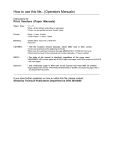
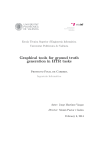
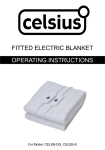
![MapInfo [v9.5 - v10.0] User manual PDF](http://vs1.manualzilla.com/store/data/005662542_1-c58f11f989f54f88b5c049879cd1b1b4-150x150.png)
